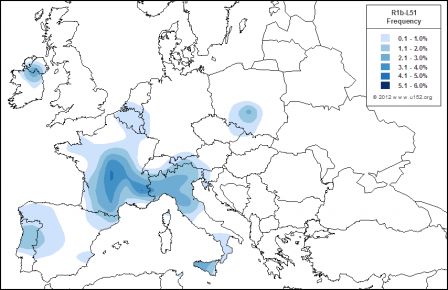Ygorcs
Active member
- Messages
- 2,259
- Reaction score
- 812
- Points
- 0
- Ethnic group
- Multiracial Brazilian
The phylogeny points broadly to North of the West Med. (as I'll explain), but I associate it with Los Millares as that matches the profile we know from the Central Beakers perfectly (warlike, metallurgical (first in W. Europe), caste-like elite, that also was part of the Bell Beaker phenomenon later on).
So (I'm posting it as I've written it up twice on anthrogenica, just because so many get confused by it it seems):The first subclade to break away from L51 not related to L52, Z2118, dates back to only 400 years after the formation of L51 (5700 years ago, so well before the migrational period of L51 Beaker folk across Western and Central Europe). The men with this subclade, in modern times, are distributed mostly around Southern France and the Rhône region. Why is that the case, if not for that general area being L51's homeland? Why, during the great Beaker migrational period, would already differentiated Z2118 men "choose" to migrate to Southern France and not throughout the rest of Western and Central Europe? It would be like time-travelling to just before the great migrational period of the Beaker folk, marking those carriers of the subclade Z2118, and seeing that the vast majority migrated to that region North of the West Med. - that is ridiculously unlikely!
An Eastern European origin of L51 would require those with branches that split at an earlier date before the great migrational period of the Beaker folk (i.e. Z2118) to have preferentially, for some reason, migrated to the vicinity of the South of France, and not elsewhere, DESPITE having been present at the earliest stages in L51's Urheimat. It would be like travelling back in time to just before the supposed great migration of L51 Westwards from E. Europe, marking those who carried this haplogroup, and seeing that the vast majority of them ended up in Southern France and the areas nearby and not so much elsewhere. There IS no reason for that, there can't be!
Well, I'm not saying it didn't necessarily happen as you think, but, you know, parental lineages may thrive and may die out completely, especially if they were never very successful to begin with, in which case even mere genetic drift can extirpate them from the local gene pool. I understand the reasons that make people associate, at least prima facie, higher diversity of subclades with the urheimat of a lineage, but I think that's not that certain as some want to believe. If, for example, a lineage developed and start to break into many subhalogroups in region A, but this region was subsequently subject to huge population displacements, star-like booms of other haplogroups (mostly replacing other lineages nearby) and massive invasions, it is totally likely that we may end up with a higher concentration of diverse subhaplogroups of that lineage in another region due to sheer chance: where more subclades managed to survive after migrations, expansions of some clades at the expense of others, population bottlenecks, genetic drift, and many other factors. Some regions just experienced more population continuity than others. It really happens.



